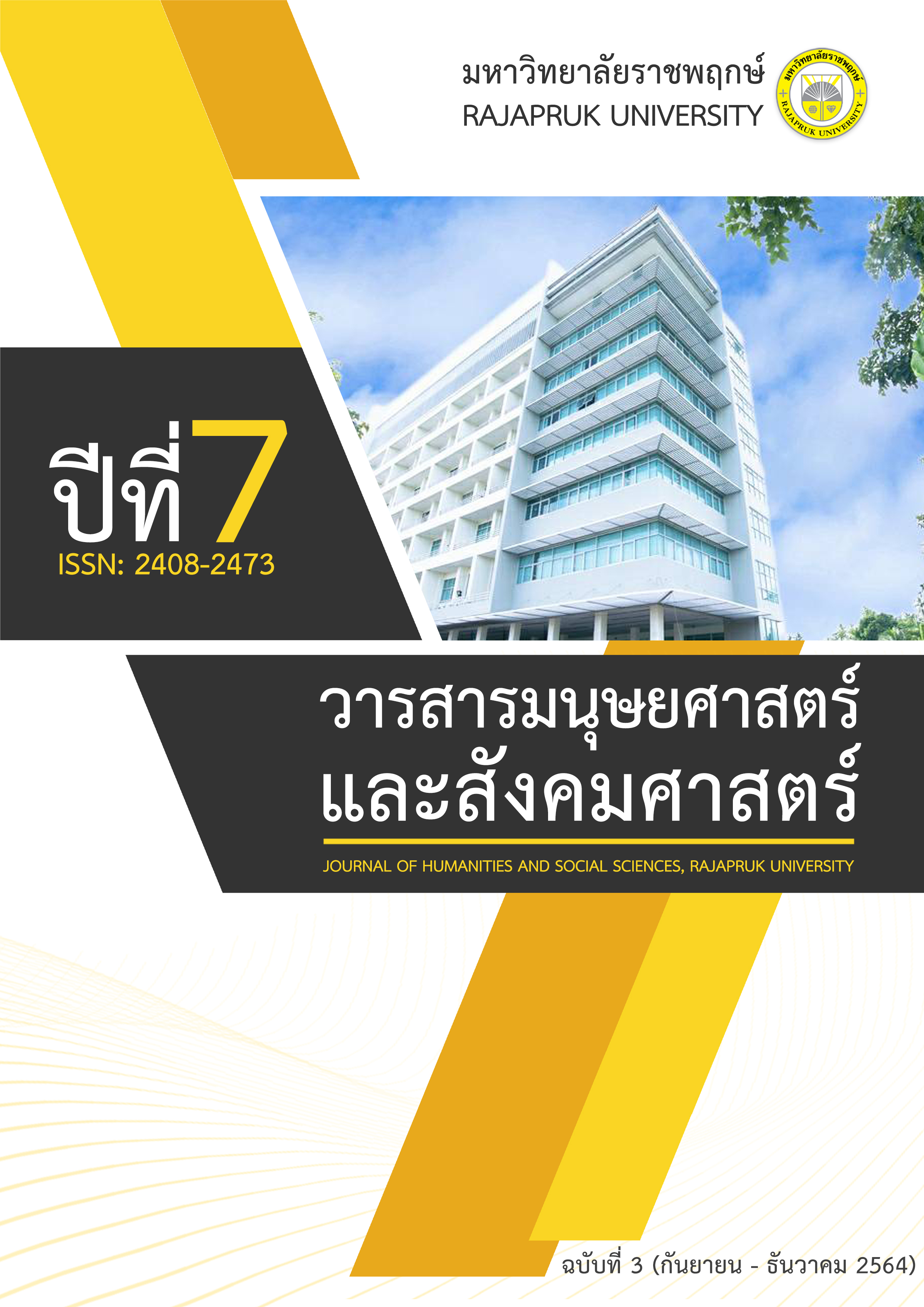The Behavior of Thai Tourists Engaged in Buddhist Religious Tourism in Phuket Province
Main Article Content
Abstract
The objectives of this research were to study 1) Thai Tourist’s Behaviors on Buddhist Religion Tourism in Phuket province. 2) Relationship between general information of Thai tourists and traveling behavior. The sample was 420 Thai tourists. The questionnaire was used as a research material. The sample was randomly selected using the quota sampling and convenience sampling, respectively. Analyzing the data by using Chi-Square (c2).
The results of the research revealed that 1) The majority of traveling behaviors were feeling stress about work. The objective was for merit-making and removing one's bad luck with a ceremony. The duration of a visit and worship was about 1 hour. The average cost of merit-making was 51-100 baht. They felt impressed and comfortable after worship. 2) The relationship between general information of tourists and traveling behavior found that the general information of tourists was related to the tourism behavior with statistical significance at the level of .05.
Article Details
References
ขนิษฐา แจ้งประจักษ์. (2554). ปัจจัยส่วนประสมทางการตลาดที่ส่งผลต่อพฤติกรรมของนักท่องเที่ยว กรณีศึกษาสามชุกตลาดร้อยปีจังหวัดสุพรรณบุรี. การค้นคว้าอิสระ ปริญญาบริหารธุรกิจมหาบัณฑิต มหาวิทยาลัยเทคโนโลยีราชมงคลธัญบุรี.
คมชัดลึก. (2556). สกว.หนุน “มจร”ชงวิจัย “จัดการท่องเที่ยวเชิงพุทธ”. ค้นเมื่อวันที่ 19 พฤศจิกายน 2561, จาก https://www.komchadluek.net/news/lifestyle/165421
ชวัลนุช อุทยาน. (2551). พฤติกรรมนักท่องเที่ยว. ค้นเมื่อวันที่ 19 ธันวาคม 2561, จาก http://touristbehaviour.wordpress.com/1/
ธนิต บุตรทิพย์สกุล. (2558). พฤติกรรมการท่องเที่ยวเชิงพุทธศาสนาของนักท่องเที่ยววัดในจังหวัดน่าน. วิทยานิพนธ์ปริญญาวิทยาศาสตรมหาบัณฑิต จุฬาลงกรณ์มหาวิทยาลัย.
บุญชัย อาสอภิสิทธิ์. (2561). พฤติกรรมการท่องเที่ยวเชิงอนุรักษ์วัฒนธรรมของกลุ่มวัยรุ่นในเขตอำเภอพระนครศรีอยุธยา จังหวัดพระนครศรีอยุธยา. รัฐศาสตรมหาบัณฑิต มหาวิทยาลัยรามคำแหง.
พรรณ์ธิดา เหล่าพวงศักดิ์. (2559). แนวทางการพัฒนาการท่องเที่ยวเชิงศาสนา เพื่อรองรับนักท่องเที่ยวกลุ่มประชาคมเกษียณ จังหวัดกาญจนบุรี. วารสารวิชาการมหาวิทยาลัยธนบุรี,
(21): 35-43.
วงศ์ระวิทย์ น้อมนำทรัพย์ และ พะยอม ธรรมบุตร. (2558). ศักยภาพของการท่องเที่ยวเชิงพุทธศาสนาจังหวัดนครปฐม. วารสารวไลยอลงกรณ์ปริทัศน์, 5(2): 151-164.
วัชรินทร์ เกิดทรัพย์. (2561). พฤติกรรมการเดินทางท่องเที่ยวของนักท่องเที่ยวกลุ่มโอเชียเนียช่วงนอกฤดูกาลท่องเที่ยวในจังหวัดภูเก็ต. วารสารมนุษยศาสตร์และสังคมศาสตร์ มหาวิทยาลัยราชพฤกษ์, 4(2) มิถุนายน–กันยายน 2561: 127-138.
วิวัฒน์ จันทร์กิ่งทอง. (2558). พฤติกรรมนักท่องเที่ยวชาวไทยในอุทยานแห่งชาติเขาน้ำค้าง จังหวัดสงขลา. การประชุมหาดใหญ่วิชาการระดับชาติ ครั้งที่ 6. วันที่ 26 มิถุนายน 2558 มหาวิทยาลัยหาดใหญ่.
สำนักงานสถิติจังหวัดภูเก็ต. (2561). จำนวนนักท่องเที่ยวชาวไทย. ค้นเมื่อวันที่ 20 ธันวาคม 2561, จาก http://phuket.nso.go.th/index.php?option=com_content&view=article&id=
&Itemid=646
สำนักพัฒนาคุณธรรมจริยธรรม. (2557). แนวทางการดำเนินงานโครงการส่งเสริมการท่องเที่ยวเส้นทางแสวงบุญในมิติทางศาสนา ปี 2557. กรุงเทพฯ: กรมศาสนา กระทรวงวัฒนธรรม.
สุรศักดิ์ ศิลาวรรณา. (2550). การท่องเที่ยวและการเผยแพร่พระพุทธศาสนา บทบาทของวัดในเขตกรุงเทพมหานคร กรณีศึกษา วัดบวรนิเวศวิหารและวัดเบญจมบพิตรดุสิตวนาราม. สารนิพนธ์ปริญญาศิลปศาสตรบัณฑิต มหาวิทยาลัยมหิดล.
Cohen, E. (1979). A Phenomenology of Tourist Experience. Sociology, 13: 179-201.
Hair, J. F., Jr., Black, W. C., Babin, B. J., Anderson, R. E., & Tatham, R. L. (2006). Multivariate Data Analysis. 6thed. New Jersey: Prentice Hall.
Perreault, W.D., & Dorden, W. R. (1979). A Psychological classification of vacation life-styles. Journal of Leisure Research, 9: 208-224.
Uysal, M and Hagan, L.A.R. (1993). Motivation of pleasure travel and tourism. New York: Van Nostrand Reinhold.
Yamane, T. (1973). Statistics: An Introductory Analysis. 3rd ed. NY: Harper & Row.


